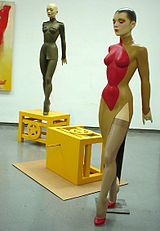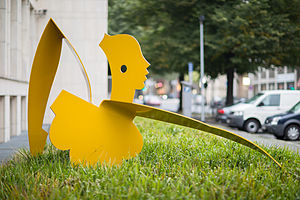ALLEN JONES “ROSSO ” n° 781 / 5000 Tema : I COLORI DELL'ARCOBALENO DI BOLAFFI ARTE Autore: ALLEN JONES
Allen Jones (Southampton, 1º settembre 1937) è uno scultore e artista pop britannico. Vive e lavora a Londra. Jones è nato a Southampton e dal 1955 al 1961 ha studiato presso il College Hornsey of Art (Londra). Nel 1960 è stato espulso dal Royal College of Art, dal 1961 al 1963 ha insegnato presso Croydon College of Art. La sua mostra di sculture erotiche, come Sedia, Tavolo e Appendiabiti (1969), è incentrata sulla furniphilia: i suoi soggetti femminili si trasformano in elementi di arredo umani. Molto del suo lavoro attinge all'immaginario del feticismo, della passione per il lattice e il BDSM. Le sculture del Korova Milkbar dal film Arancia meccanica si ispirano alle opere di Jones, dopo che questi respinse la richiesta di Stanley Kubrick di curare la scenografia del film senza compenso. Jones ha curato il design nel film Maîtresse del 1975 diretto da Barbet Schroeder. Nel 1986 è stato nominato membro della Royal Academy. David Gilmour, chitarrista dei Pink Floyd, tiene in mano una copia di Figures di Allen Jones durante le porzioni di intervista in Pink Floyd: Live at Pompeii. Hatstand, Table and Chair (1970)
Jones first group of erotic fibreglass sculptures, of a Hatstand, Table and Chair gained international attention when exhibited in 1970. The works were met with strong protests for perceived misogyny, which succeeded in making Jones a "cultural hot potato".Laura Mulvey writing for Spare Rib magazine suggested the sculptures was inspired by latent castration anxiety. Almost a decade later, when they were put on display at the Institute of Contemporary Arts in 1978, they were attacked with stink bombs. Eight years later, on International Women's Day, Chair was damaged by paint stripper while exhibited at the Tate. According to art historian and curator, Marco Livingstone, writing in 2004: "More than three decades later, these works still carry a powerful emotive charge, ensnaring every viewer's psychology and sexual outlook regardless of age, gender or experience. The severe reaction from the art world, feminists, and the mainstream press after the sculptures' debut would limit Jones' exhibition career in England over the next several decades. When asked about their effect on his career, Jones was quoted stating "it's collateral damage. I wanted to offend the canons of accepted worth in art. I found the perfect image to do that, and it's an accident of history that these works coincided with the arrival of militant feminism." Roman Polanski, Elton John and Gunter Sachs all owned a piece at one stage, with one of the sets selling at auction in 2012 for £2.6 million. The sculptures have also been referenced in Stanley Kubrick's 1971 film A Clockwork Orange. Maîtresse and teaching (1973–1980s)Jones, photographer Brian Duffy, and air brush specialist Philip Castle were commissioned to collaborate on the annual and often salacious Pirelli calendar in 1973, resulting in a unique edition that Clive James would later jokingly call "the only Pirelli Calendar that nobody bothered to look at twice". In 1973, Jones spent time as a guest lecturer at the University of California, Los Angeles, and after visiting Japan in 1974, the following year he toured Canada.Jones designed Barbet Schroeder's 1975 film Maîtresse. Starring Bulle Ogier as the professional dominatrix Ariane and Gérard Depardieu as her obsessed lover, the film was refused a certificate in the United Kingdom because of its graphic depictions of sado-masochism. By the mid 1970s, he was again focusing on canvas and painting, and among his notable works at this time were Santa Monica Shores in 1977. Now at the Tate, the work was painted while he was a guest lecturer at the University of California, Los Angeles in 1977, and later that summer he was a visiting director of studies in drawing and painting in Alberta, Canada, at the Banff Center School of Fine Arts. Known for only very occasionally taking on commissions, Jones was commissioned to design a hoarding for Fogal, a hosiery manufacturer, at Basel station in 1978. The Walker Art Gallery in Liverpool held a large retrospective exhibition on his work in 1979, and the exhibit later travelled to the Serpentine Gallery in London. Continuing to travel, he was invited by the Berlin University of the Arts to be a guest professor from 1982 to 1983. By that time, he had largely returned to "a playful stylisation in figure sculptures," including The Tango in 1984, a life-size dancing couple made from steel plate.In 1986, his work was included in the Venice Biennale's Art e Scienza exhibition, alongside artists such as Brian Eno and Tony Cragg,and that year he was elected as a Royal Academician by the Royal Academy. Opened in 1987, Birch and Conran was the first art gallery in Soho, and their inaugural show featured British Pop artists such as Jones, Sir Peter Blake, Richard Hamilton, and Clive Barker. From 1990 to 1999, he served as a trustee at the British Museum, and in 2000 became an Emeritus Trustee. He has works held by the Cass Sculpture Foundation. One of which, the outdoor sculpture Temple from 1998, was Also, with the figure at top of the structure Jones uses "colour to introduce the notion of movement in the figure, with the alternate arms of yellow and green in diagonally opposing positions." Recent exhibitions and holdings (2000s)Jones continued his artistic activity into the 2000s, and among other projects he incorporated leatherwork by Whitaker Malem. In recent years, Jones has increasingly become known for his large steel sculptures, many of which are abstract in nature and feature intertwining figures. A number of them were displayed in an outdoor exhibit in May 2015 at the Art in the Park event held by Lake Zurich.His work is also included in a number of public and private art collections; three of his paintings are in the collection of the Centro de Arte Moderna of the Gulbenkian Foundation in Lisbon, and he has pieces in the Ingram Collection of Modern British Art. In 2007, he was awarded an honorary Doctorate of Arts from Southampton Solent University. He has had solo exhibitions at the Wetterling Teo Gallery in Stockholm and the Serge Sorokko Gallery. His works featured in the Pop Art Portraits show at the National Portrait Gallery in London, and had a dedicated room of watercolours, drawing and paintings at the Tate Britain. In 2008, he was given a dedicated watercolour room at the Royal Academy of Arts. In April 2013, his work was included in a major exhibition at the National Museum of Wales in Cardiff, titled Pop and Abstract, alongside work by artists like Peter Blake and Bridget Riley.A parody of Jones Chair sculpture was part of a collection exhibited under the name Allen Jones Remake at the Venus Over Manhattan Gallery in New York in 2013.An example of Jones' 1969 Chair sculpture (as well as over fifty other works) remains at the Tate, which was acquired in 2014. In November 2014, a retrospective on Jones opened at the Royal Academy of Arts, running until January 2015 in London. Artistic style and influencesAssociated with the British Pop art movement of the late 1960s,Jones is known for his work with lithography, painting, drawing, and sculpture. The Cass Sculpture Foundation wrote about Jones' work that "on a flat canvas, painted forms appear sculptural and his three-dimensional works are painterly. He uses colour to describe form, at times with graphic precision, or conversely with an energy and freedom of gesture which is close to direct expression. Similar developments are evident in his printmaking."The Tate has described his output in lithography as "prolific," writing that it "proved an appropriate medium for his graphic flair."Artists and pop fashion designers such as Alexander McQueen, Issey Miyake and Richard Nicoll have cited Jones as an influence on their own styles. Jones is known for incorporating erotic imagery into his works, including rubber fetishism and BDSM, and this sexuality has often been a focus of both art critics and the press.[20] Mark Hudson wrote in 2014 that Jones' "subjects have included musicians, dancers and London buses, but in the popular perception his name is irrevocably linked to his peerlessly kinky fetish women, whether in two or three dimensions, with their machined surfaces and blank expressions – images that are as emblematic of classic British pop art as Peter Blake's Beatles paintings or Hockney's swimming pools."In a review on Jones' career, Richard Dorment wrote in November 2014 that "you could argue that Jones's work isn't really about women; it's about men and how they look at and think about women. Men use various strategies to neutralise or control desire. One is to fetishise the female body...[while] another is for the man to appropriate it." Dorment further explains himself by writing tha | ||||



